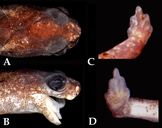|
Description
Relative to other members of the genus Nototriton, N. tomamorum is a small species (snout-vent length=26.9 mm, total length=51.4 mm), and differs from all congeners in having relatively large nares, syndactylous hands and feet, and a pale ventral coloration with gray mottling. Nototriton tomamorum is known only from a single, presumably female specimen (mental gland and cloacal papillae absent), and is a relatively small member of the genus with a slender body and reduced limbs, a rounded head that is slightly broader than the body, nares are relatively large, and the snout is rounded and of moderate length. The nasolabial protuberances are not well developed, and barely extend below the upper lip line. The eyes are relatively large and protuberant. There are 26 maxillary teeth, 4 premaxillary teeth set slightly forward from the maxillaries, and 11 vomerine teeth arranged in two short medially-positioned arches. The limbs are short, with the adpressed limbs being separated by approximately 5.5 costal grooves. The hands and feet are narrow and have poorly-developed, poorly-differentiated digits that are fused and lack subdigital pads. The free tips of digits III on the hands and III and IV on the feet are pointed, and digits I, II and IV on the hands and I, II, and V on the feet are very short and essentially completely fused, being demarcated by shallow grooves on the dorsal side of the feet. The tail is slightly shorter than the body (tail length/SVL=0.91), with a slight basal constriction most apparent on the ventral side, and is slightly compressed laterally (tail depth 1.17 times tail width at level of basal constriction) (Townsend et al. 2010). Distribution and Habitat
Country distribution from AmphibiaWeb's database: Honduras
This species is only known from the type locality at 1550 m elevation, about 2.5 km NNE of the small community of La Fortuna on the southern side of Refugio de Vida Silvestre Texiguat in Departamento de Yoro, Honduras (Townsend et al. 2010). The type locality is in the Lower Montane Wet Forest formation (Holdridge 1967), commonly referred to as cloud forest.Life History, Abundance, Activity, and Special Behaviors
The single known specimen of Nototriton tomamorum was collected during the daytime from leaf litter packed onto a rock ledge in a narrow, steep-sided canyon with riparian forest, and more xeric upland pine-oak forest dominating the terrain above the canyon (Townsend et al. 2010). Trends and Threats
Based on IUCN criteria, Nototriton tomamorum should be classified as Critically Endangered (B1ab[iii]+2ab[iii]) due to the extremely limited extent of its known distribution and the direct threat to the remaining habitat around that locality, principally from illegal timber extraction and wholesale slash-and-burn clearing of forest following illegal timber extraction. In April 2008, Townsend et al. (2010: 11) observed that a large stretch of forest upstream from the type locality of Nototriton tomamorum had been clear-cut down to the streamside and planted to beans. The canyon from which the N. tomamorumholotype was collected is also the type locality for the single site endemic Isthmohyla insolita. Possible reasons for amphibian decline General habitat alteration and loss
Habitat modification from deforestation, or logging related activities
Intensified agriculture or grazing
Comments
Phylogenetically, N. tomamorum is the basal sister to the remaining Honduran species of the N. barbouri group, a similar relationship as that of the morphologically similar Costa Rican species N. richardi to the N. picadoi group (Townsend et al. 2010).
The specific name “tomamorum” means “belonging to the Tomams.” Tomams are the highest level of deities recognized in the belief system of the indigenous Tolupan of Honduras. The name is given in recognition that the Tolupan are the traditional inhabitants of this area and that this new species is known only from the Cordillera Nombre de Dios, or “Name of God Mountains” (Townsend et al. 2010).
References
Holdridge, L. R. (1967). Life Zone Ecology. Tropical Science Center, San Jose, Costa Rica.
Townsend, J. H., Butler, J. M., Wilson, L. D., and Austin, J. D. (2010). ''A distinctive new species of moss salamander (Caudata: Plethodontidae: Nototriton) from an imperiled Honduran endemism hotspot.'' Zootaxa, 2434, 1-16.
Originally submitted by: Josiah Townsend (first posted 2010-06-29)
Edited by: Kellie Whittaker (2011-03-08)Species Account Citation: AmphibiaWeb 2011 Nototriton tomamorum <https://amphibiaweb.org/species/7485> University of California, Berkeley, CA, USA. Accessed May 5, 2025.
Feedback or comments about this page.
Citation: AmphibiaWeb. 2025. <https://amphibiaweb.org> University of California, Berkeley, CA, USA. Accessed 5 May 2025.
AmphibiaWeb's policy on data use.
|




 Raffaëlli Account
Raffaëlli Account Map of Life
Map of Life